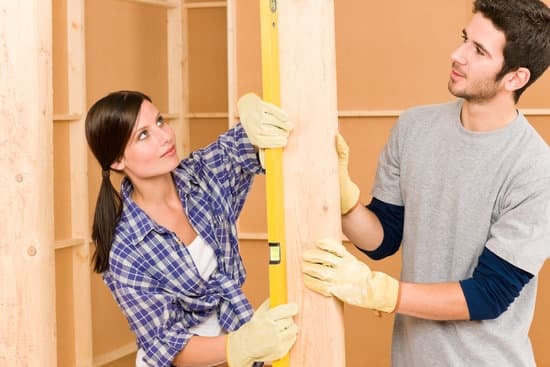When it comes to making improvements to your home, you may be wondering what costs can be deducted from your taxes. Homeowners often overlook the fact that certain home improvements can actually provide tax benefits. So, what home improvements are tax deductible?
In this article, we will explore the concept of tax deductions for home improvements and shed light on the criteria that determine eligibility. Whether you’re considering repairs, energy-efficient upgrades, or modifications for medical necessity, understanding how these expenses can impact your taxes is crucial.
Making home improvements not only enhances the aesthetic appeal and functionality of your property but can also have financial benefits when it comes to filing your taxes. By taking advantage of tax deductions for home improvements, you may be able to reduce your overall tax liability and save money. However, it’s important to note that not all home improvement expenses qualify for deductions.
To determine if a specific expense is eligible for a tax deduction, there are certain criteria that must be met. Understanding these factors is key in maximizing potential savings. Additionally, it’s important to differentiate between repairs and improvements as they are treated differently when it comes to tax deductions.
In the following sections of this article, we will delve deeper into each aspect related to tax deductions for home improvements. We will explore energy-efficient upgrades and medical necessity modifications which may qualify for deductions. Furthermore, we will discuss how certain home office expenses and capital gains from increased property value can also be eligible for tax benefits. Additionally, we will provide guidance on documenting expenses accurately and debunk common misconceptions surrounding the topic.
Before diving into the specifics of each category with regards to tax deductions for home improvements, understanding the concept as a whole is essential. Through this article, we hope to inform homeowners about the possibilities available when it comes to saving money through their efforts in improving their homes while also providing them with helpful guidance along the way.
Understanding the Criteria
When it comes to claiming tax deductions for home improvements, it’s important to understand the key eligibility factors that determine whether or not your expenses are deductible. The Internal Revenue Service (IRS) has specific guidelines in place to determine which home improvement expenses can be claimed as deductions and which cannot. Here are some of the main criteria you need to consider:
- Ownership and Use: In order to claim tax deductions for home improvements, you must own the property where the improvements were made. Additionally, the property must be used for personal purposes and not as a rental or investment property.
- Capital Improvement vs. Repairs: One crucial factor in determining deductibility is whether an expense qualifies as a capital improvement or a repair. Capital improvements generally add value to your property or prolong its useful life, while repairs simply restore it to its original condition. Only capital improvements can be claimed as deductions, so it’s important to keep track of these expenses separately.
- Main Home vs. Second Home: Tax deductions for home improvements generally apply only to your main residence. If you have a second home or vacation property, you may still be eligible for certain deductions, but they may be limited compared to those available for your primary residence.
It’s worth noting that tax laws regarding home improvement deductions can vary by jurisdiction and change over time, so it’s essential to consult with a qualified tax professional who is knowledgeable about current regulations in your area. They can provide personalized advice based on your specific situation and help ensure that you comply with all necessary requirements when claiming deductions for home improvements.
Remember that proper documentation is crucial when claiming tax deductions for home improvements. Keep records of all receipts, invoices, contracts, and any other relevant documents associated with your home improvement projects. This will help support your claims and make the process smoother if you are audited by the IRS.
Repairs vs. Improvements
When it comes to tax deductions for home improvements, it is important to understand the key distinction between repairs and improvements. While both may involve making changes or alterations to your home, they have different implications when it comes to tax deductions. Understanding this difference can help homeowners maximize their potential tax benefits.
Repairs
Repairs are generally considered necessary fixes to restore or maintain the current condition of a property. These may include fixing leaks, replacing broken windows, repairing a damaged roof, or fixing faulty plumbing or wiring. Repairs are essential for the upkeep of a home and are seen as routine maintenance tasks rather than upgrades that enhance the value of the property.
For tax purposes, repairs are typically not deductible as they are considered part of regular homeownership expenses. However, there are situations where certain repair costs can be deducted if they are directly related to other eligible deductions such as casualty losses due to natural disasters or theft.
Improvements
On the other hand, improvements refer to enhancements made to a property that increase its value, prolong its useful life, or adapt it for new uses. Examples of home improvements include adding an extra room, installing a swimming pool, renovating a kitchen or bathroom, or upgrading heating and cooling systems.
The good news is that many home improvements can be tax deductible. However, these deductions will typically only apply when you sell your home and can be claimed through capital gains exclusions (discussed in section 7). It’s important to note that the cost of improvements themselves cannot be directly deducted from your taxes each year but can potentially be factored into your overall gain when calculating taxable profits from selling your house.
Understanding the distinction between repairs and improvements is crucial for homeowners who want to make informed decisions about which expenses may qualify for tax deductions. If you’re unsure about whether a particular project falls under repairs or improvements, it’s recommended to consult with a tax professional for personalized advice and guidance.
By fully comprehending the difference between repairs and improvements, homeowners can ensure they accurately document their expenses and maximize any potential tax benefits they may be entitled to receive. The next section will explore tax deductions specifically related to energy-efficient upgrades for homes.
Energy-Efficient Upgrades
Energy-efficient upgrades can provide homeowners with both environmental benefits and potential tax deductions. The government encourages individuals to make energy-efficient choices by offering various tax incentives and credits. These incentives are aimed at reducing energy consumption, promoting sustainability, and combating climate change. By taking advantage of these tax deductions, homeowners can save money while also contributing to a greener planet.
One popular tax deduction for energy-efficient home improvements is the Residential Energy Efficient Property Credit. This credit allows homeowners to claim a percentage of the cost of qualifying renewable energy equipment installed in their homes. Examples of eligible upgrades include solar panels, geothermal heat pumps, and small wind turbines. The credit is worth 30% of the qualifying costs and has no upper limit on its value.
Another commonly utilized tax deduction is the Nonbusiness Energy Property Credit. This credit applies to certain energy-efficient upgrades made to primary residences and can be claimed for items such as insulation, windows, doors, and roofs. Homeowners can receive a credit equal to 10% of the cost of materials, up to a maximum limit of $500.
In addition to these credits, there are also state-specific incentives and programs that provide tax deductions for energy-efficient improvements. These programs vary by location and can include rebates, grants, or exemptions from sales taxes on certain products. It is important for homeowners to research their state’s specific offerings or consult with a tax professional to maximize their potential savings.
Overall, investing in energy-efficient upgrades not only helps reduce utility bills but can also lead to valuable tax deductions. By choosing eco-friendly options for home improvements and taking advantage of available credits or incentives, homeowners can both save money and contribute positively towards a more sustainable future.
| Tax Deduction | Description |
|---|---|
| Residential Energy Efficient Property Credit | A credit worth 30% of the cost of qualifying renewable energy equipment installed in a home, such as solar panels or geothermal heat pumps, with no upper limit on its value. |
| Nonbusiness Energy Property Credit | A credit equal to 10% of the cost of materials for certain energy-efficient upgrades made to primary residences, up to a maximum limit of $500. |
Medical Necessity Modifications
When it comes to tax deductions for home improvements, homeowners may be pleased to find out that certain modifications made for medical necessity can be eligible for tax benefits. These modifications are intended to accommodate individuals with disabilities or medical conditions, making their homes more accessible and convenient for daily living. However, it is vital to understand the criteria and requirements in order to claim these deductions accurately.
Eligibility Criteria
To qualify for tax deductions on home improvements made for medical necessity, a homeowner must meet specific eligibility criteria set by the Internal Revenue Service (IRS). Firstly, the cost of the modification must be directly related to accommodating a disability or medical condition. This includes extending doorways, installing ramps or lifts, modifying bathrooms and kitchens, or adding accessible features such as handrails and grab-bars.
Moreover, the improvement should be essential for medical care and must not increase the value of the property beyond what is reasonable in relation to its overall value. It is crucial to keep in mind that cosmetic upgrades or general maintenance tasks usually do not qualify as medical necessity modifications.
Documentation and Deductions
In order to claim tax deductions for home improvements made for medical necessity, proper documentation is key. Homeowners should maintain accurate records that demonstrate both the cost of the improvement and its direct relationship to accommodating a disability or medical condition. This may include invoices from contractors or suppliers, receipts for materials purchased, and any relevant medical documentation supporting the necessity of the modification.
It is recommended that homeowners consult with a tax professional when claiming these deductions since they can provide guidance on specific rules and regulations related to this type of deduction. Additionally, they will ensure that all necessary documents are in order before filing taxes. By following these guidelines and seeking appropriate advice if needed, homeowners can take advantage of the potential tax benefits associated with home improvements made for medical necessity.
Home Office Expenses
For individuals who have a designated home office, there is an opportunity to claim tax deductions for certain home improvements. These deductions can help offset the costs of renovating or improving your workspace. However, it’s important to understand that not all home office expenses are eligible for tax deductions. To take advantage of these deductions, you need to meet certain criteria and document your expenses properly.
The first requirement for claiming tax deductions on home office expenses is that the space must be used exclusively for business purposes. This means that if you have a room in your house that serves as both a home office and a guest bedroom, you cannot deduct the cost of any improvements made to that space. The IRS requires that the area be used regularly and exclusively for work-related activities.
Once you meet the exclusivity requirement, you may be able to deduct expenses related to improving your home office. This includes renovations or upgrades directly related to your work, such as installing built-in shelves or cabinets, upgrading electrical wiring or lighting fixtures, or adding soundproofing materials. It’s important to note that general repairs or maintenance tasks are typically not eligible for deductions unless they are specifically tied to your business needs.
To ensure proper documentation for these deductions, keep records of all expenses related to your home office improvements. This includes receipts, invoices, contracts, and any other relevant documents. Additionally, keep track of the square footage of your home office compared to the total square footage of your residence. This will be needed when calculating the percentage of expenses that can be claimed as deductions.
Capital Gains Exclusion
When it comes to home improvements, not only can they enhance the aesthetics and functionality of your property, but they can also provide potential tax benefits. One significant tax benefit to consider is the capital gains exclusion. By making certain improvements that increase the value of your property, you may be eligible for tax benefits when you sell your home.
Under current tax laws, homeowners can exclude up to $250,000 ($500,000 for married couples filing jointly) of capital gains from the sale of their primary residence. This exclusion applies to any profits made from the sale of a home as long as certain requirements are met. One important requirement is that you must have owned and used the property as your primary residence for at least two out of the five years prior to selling it.
To take advantage of this exclusion, it’s crucial to understand what types of home improvements qualify. Generally speaking, any improvement that adds value to your property or enhances its lifespan may potentially qualify for increasing its basis. Some examples include additions or extensions, kitchen or bathroom renovations, installing a new roof or HVAC system, and landscaping upgrades.
It’s important to note that routine repairs or maintenance expenses do not count as capital improvements for tax purposes. However, if the repair is necessary due to damage caused by a specific event such as a fire or natural disaster, it may be considered part of the cost basis and therefore contribute towards reducing potential taxable gain.
In order to properly document these improvements and establish their impact on the property’s value, it’s crucial to keep detailed records including receipts, invoices, permits (if required), before-and-after photos and written explanations from contractors regarding the work done. This documentation not only validates your claims but also helps in maximizing potential tax benefits.
By understanding and taking advantage of tax deductions for home improvements through capital gains exclusions, homeowners can effectively reduce their taxable gains when selling their properties. However, it is advisable to consult with a qualified tax professional or accountant to ensure compliance with tax laws and to get personalized advice based on your specific circumstances.
They can provide guidance on the types of improvements that qualify for this exclusion and help you navigate through the complex tax regulations, ultimately maximizing your potential tax benefits.
Documenting Expenses
Proper documentation is crucial when it comes to claiming tax deductions for home improvements. Without adequate documentation, homeowners may miss out on potential tax benefits or face difficulties if their deductions are audited by the Internal Revenue Service (IRS). This section will provide guidance on the importance of documenting expenses and the types of documents that should be kept for tax purposes.
When claiming tax deductions for home improvements, it is essential to keep receipts, invoices, and any other relevant proof of payment. This documentation serves as evidence of the expenses incurred and helps verify that the improvements were made. Homeowners should also keep records of any contracts or agreements related to the home improvements, as well as before-and-after photos to support their claims.
To ensure accurate documentation, it is advisable to separate costs between repairs and improvements. While repairs generally do not qualify for tax deductions, they are still important to document in case there are overlapping expenses with eligible improvements. Additionally, keeping a detailed logbook or spreadsheet can help track all expenses related to the home improvements throughout the year.
Moreover, it is crucial to retain records beyond the current tax year. The IRS typically requires taxpayers to keep records supporting their deductions for at least three years from the date they filed their returns or two years from when they paid the taxes-whichever is later. However, it is prudent to retain these records for a longer period in case of an audit or if questions arise in subsequent years.
| Types of Documents | Description |
|---|---|
| Receipts | Proof of payment for materials and labor |
| Invoices | Bills from contractors or suppliers |
| Contracts/Agreements | Any written agreements related to the home improvements |
| Before-and-After Photos | Visual evidence of the changes made |
| Logbook/Spreadsheet | A detailed record of all expenses incurred throughout the year |
By diligently documenting expenses and keeping accurate records, homeowners can confidently claim tax deductions for their home improvements and avoid potential issues with the IRS. It is advisable to consult with a tax professional or refer to IRS guidelines for specific documentation requirements and further assistance in claiming these deductions.
Common Misconceptions
Many homeowners are often confused or misinformed about the tax deductions available for home improvements. This section aims to debunk some common myths and misconceptions surrounding this topic. By clarifying these misconceptions, homeowners can make informed decisions about their home improvement projects and properly take advantage of any potential tax benefits.
Myth 1: All home improvements are tax deductible
One common misconception is that all home improvements automatically qualify for tax deductions. However, not all home improvements are eligible for tax deductions. In order to be eligible, the improvement must meet certain criteria, such as being a capital improvement that adds value to your property or being made for specific medical necessity purposes. It’s important to understand the specific eligibility factors discussed in earlier sections to determine whether a particular improvement qualifies for tax deductions.
Myth 2: Minor repairs can be claimed as tax deductions
Another misconception is that minor repairs made around the house can be claimed as tax deductions. However, it’s important to differentiate between repairs and improvements. While repairs generally do not qualify for tax deductions, certain substantial improvements that enhance the value or energy efficiency of your home may be eligible. Repairs include tasks such as fixing a leaky roof or repairing broken windows, whereas improvements involve more significant renovations like adding a new room or upgrading insulation.
Myth 3: Tax deductions equal full reimbursement
A common misunderstanding is that if an improvement qualifies for a tax deduction, it will result in full reimbursement of its cost. In reality, tax deductions only reduce the amount of taxable income, which ultimately lowers your overall taxes owed.
The amount you can claim as a deduction depends on various factors including your income level and the type of improvement made. It’s important to consult with a qualified tax professional who can provide personalized advice based on your individual circumstances.
By dispelling these common myths and misconceptions, homeowners can better navigate the complex landscape of tax deductions for home improvements. It is always recommended to seek guidance from a knowledgeable tax professional who can provide accurate and up-to-date information based on current tax laws and regulations. Understanding the criteria, documenting expenses properly, and seeking professional advice are essential steps in maximizing any potential tax benefits associated with home improvements.
Seek Professional Advice
Seeking professional advice is crucial when it comes to understanding tax deductions for home improvements. While this article provides a general overview of the topic, individual circumstances can greatly impact eligibility and the specific deductions available. Consulting with a tax professional ensures that you receive personalized information and advice tailored to your unique situation.
The Benefits of Professional Advice
Tax professionals, such as certified public accountants (CPAs) or tax attorneys, have in-depth knowledge of current tax laws and regulations. They stay up-to-date with any changes that may affect home improvement deductions. Their expertise allows them to accurately assess your eligibility and identify potential deductions you may not be aware of.
Additionally, tax professionals can interpret complex tax language and help you understand how it applies to your specific situation. They will ask for relevant financial documents and details about your home improvements to determine which deductions may be applicable in your case. This level of personalized attention ensures that you maximize your potential deductions while minimizing the risk of an IRS audit.
Where to Find a Tax Professional
When searching for a tax professional, it’s important to choose someone who specializes in real estate taxation or has experience in handling home improvement deductions. Consider seeking recommendations from friends, family members, or colleagues who have had positive experiences with their own tax professionals.
You may also explore professional organizations such as the American Institute of Certified Public Accountants (AICPA), which allows you to search for CPAs specialized in real estate taxation services. Online directories, like the National Association of Tax Professionals (NATP), can also help you find qualified professionals near you.
Remember that fees for tax professionals vary depending on their level of expertise and geographic location. Be sure to inquire about costs upfront so there are no surprises later.
By seeking professional advice for understanding what home improvements are tax deductible, individuals can navigate the complexities of the tax code with confidence and ensure they are taking full advantage of available deductions. It’s a proactive approach that can save you money, protect against potential audit risks, and provide peace of mind when it comes to your home improvement projects.
Conclusion
In conclusion, understanding tax deductions for home improvements is crucial for homeowners who want to maximize their potential savings. Throughout this article, we have explored the various factors that determine eligibility for tax deductions, such as the distinction between repairs and improvements and their impact on deductions. We have also discussed specific types of home improvements that may qualify for deductions, including energy-efficient upgrades, modifications made for medical necessity, and improvements related to a home office.
It is important to note that proper documentation is essential when claiming tax deductions for home improvements. Keeping receipts, contracts, and other relevant documents will not only make the process smoother but also provide evidence in case of an audit. Additionally, debunking common misconceptions about tax deductions can help homeowners avoid making costly mistakes.
However, it is important to acknowledge that tax laws are complex and subject to change. Therefore, seeking professional advice from certified tax professionals is highly recommended. These experts can provide personalized information tailored to your specific circumstances and help you navigate the intricacies of the tax code.
Frequently Asked Questions
Can you write off home improvements on your taxes?
In general, home improvements are not tax-deductible. However, there are certain situations where you may be able to claim tax benefits for home improvements. For example, if a home improvement project qualifies as a medical expense or is related to the installation of energy-efficient systems, you might be eligible for deductions or credits.
Medical expenses that make your home more accessible for someone with a disability may qualify as a deduction. Additionally, installing energy-efficient systems like solar panels or insulation can make you eligible for valuable tax credits. It’s important to consult with a tax professional or review the IRS guidelines to determine if your specific home improvement expenses qualify for any tax benefits.
Is replacing a roof tax-deductible?
In most cases, the cost of replacing a roof is not directly tax-deductible. Roof replacement is typically considered a home improvement rather than a repair, and therefore does not offer any immediate tax advantages. However, similar to other home improvements, there are instances where replacing a roof may provide some indirect tax benefits.
For instance, if you install an energy-efficient roof that meets specific requirements set by the government, you might be eligible for energy-saving tax credits or incentives. Again, it’s crucial to consult with a tax professional or refer to the IRS guidelines to understand if your roof replacement qualifies for any applicable tax breaks.
Is a new HVAC system tax-deductible 2023?
Tax deduction rules can change over time and vary depending on different factors such as location and individual circumstances. As of now (2021), there are no specific federal laws allowing direct deductions for new HVAC system purchases in 2023 exclusively.
Nonetheless, similar to other types of home improvements and energy-efficient upgrades mentioned earlier, installing an HVAC system that meets certain criteria might make you eligible for available tax credits or incentives provided by federal or state programs at that time. These incentives can change periodically, so it’s important to stay updated on current regulations by referring to official IRS publications or seeking advice from qualified professionals when planning major expenses like a new HVAC system.

I’m thrilled to have you here as a part of the Remodeling Top community. This is where my journey as an architect and remodeling enthusiast intersects with your passion for transforming houses into dream homes.





